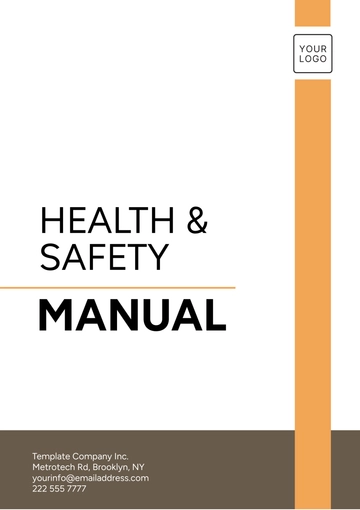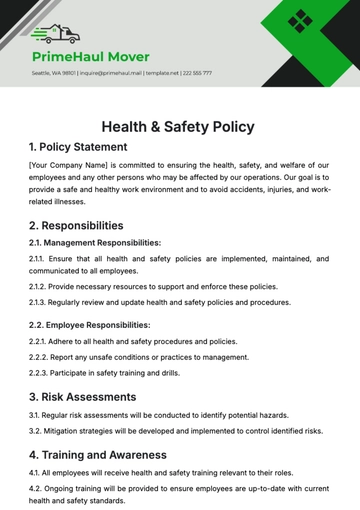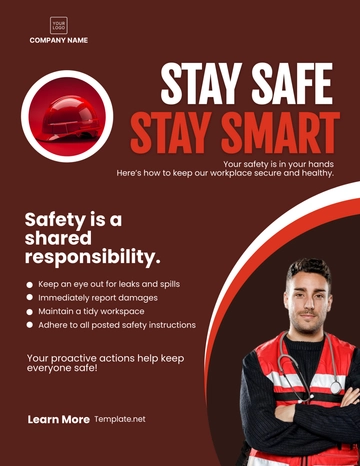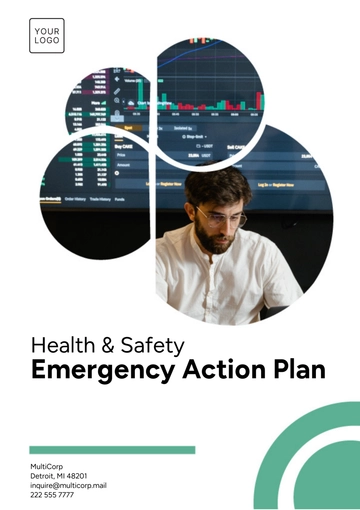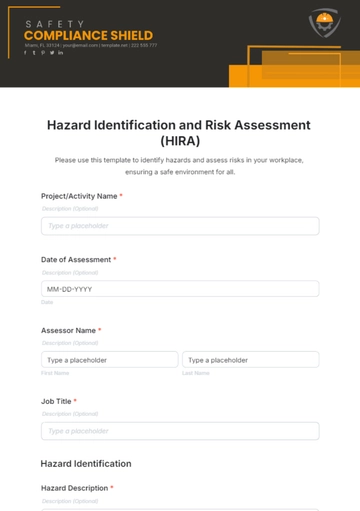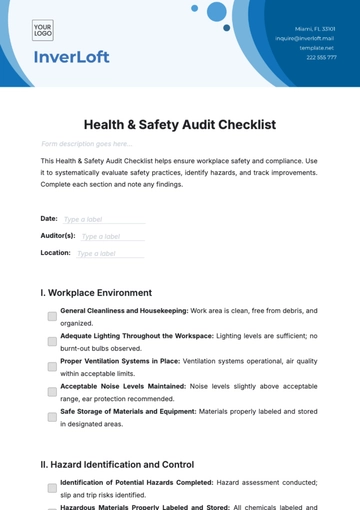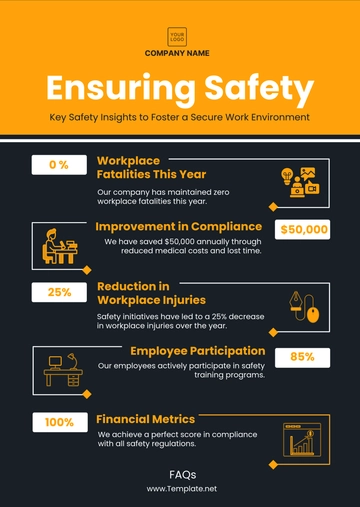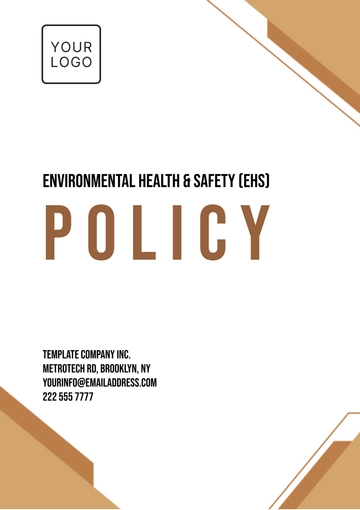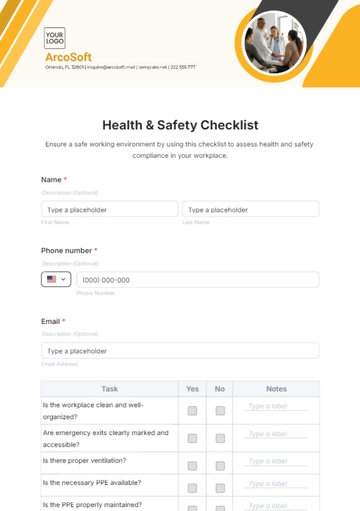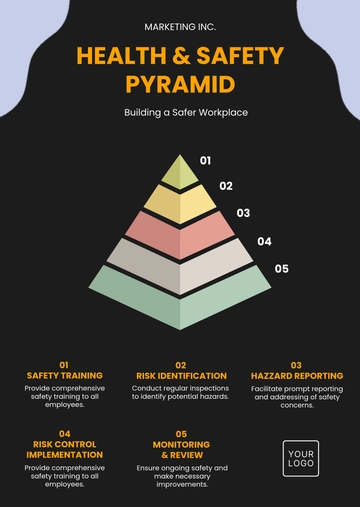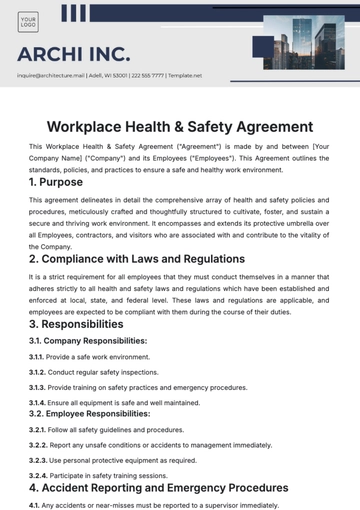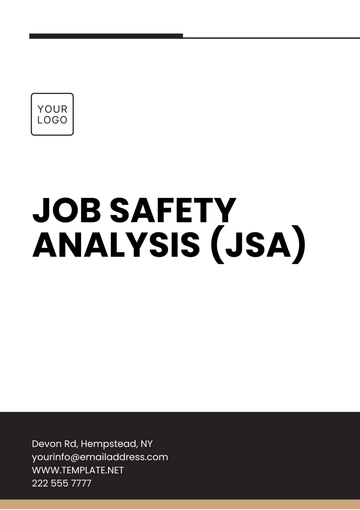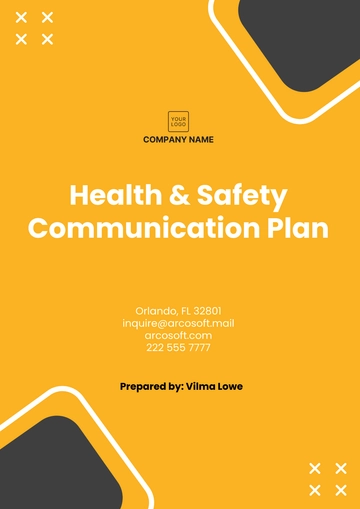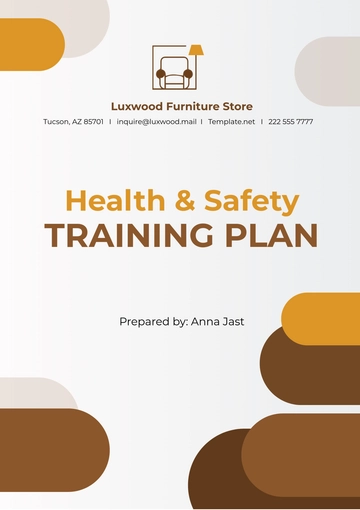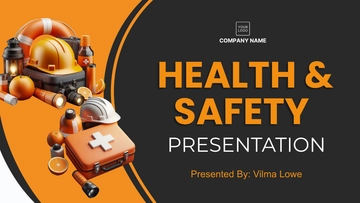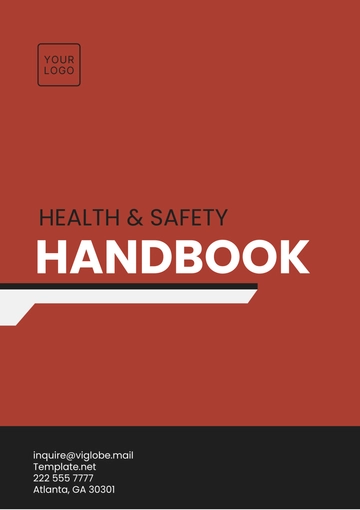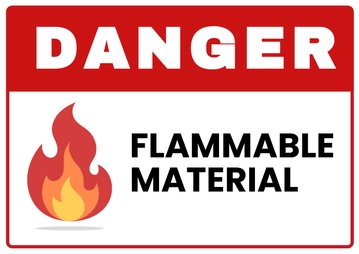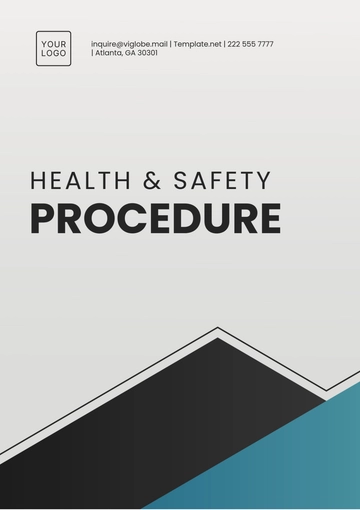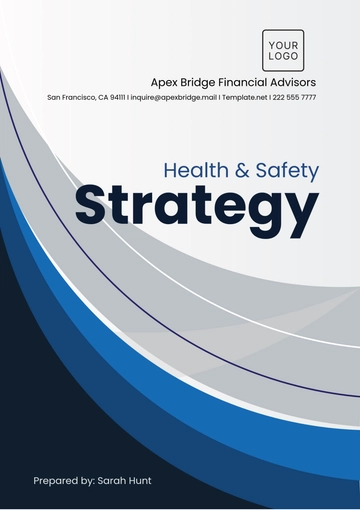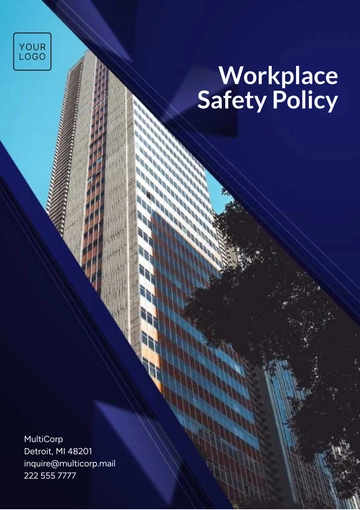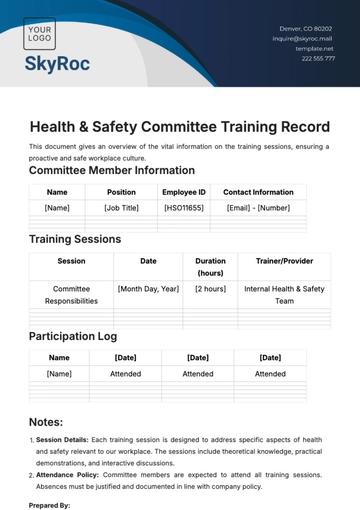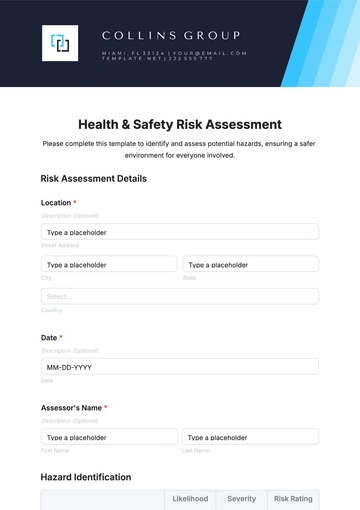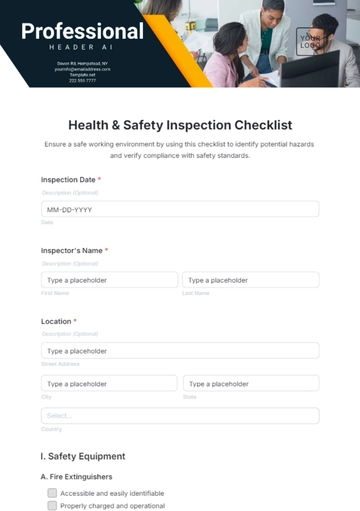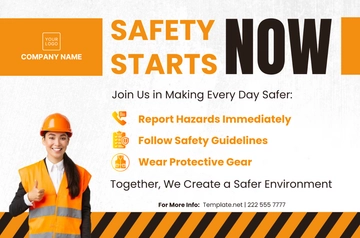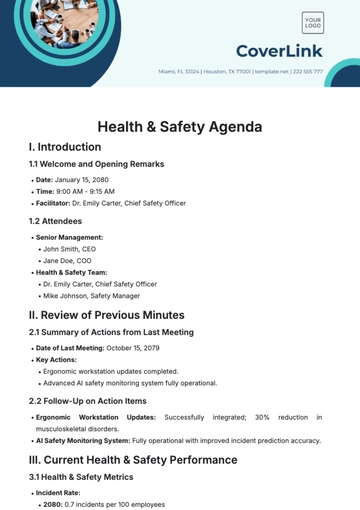Free Health & Safety Awareness Documentation

Introduction
A. Purpose
This Health and Safety Awareness Documentation serves as a comprehensive guide outlining [Your Company Name]'s commitment to fostering a secure and healthy working environment. It aims to provide employees with the necessary information and guidelines to understand, implement, and maintain health and safety standards within the organization.
B. Scope
This document covers all employees, contractors, and visitors at [Your Company Name] premises and includes all activities conducted within the workplace. It encompasses both office and operational areas, emphasizing the importance of health and safety across all functions and levels within the organization.
Health and Safety Policy
A. Policy Statement
[Your Company Name] is dedicated to ensuring the well-being of its employees by maintaining a safe and healthy working environment. Our policy emphasizes the following key principles:
Prevention: [Your Company Name] is committed to proactively identifying and mitigating potential hazards to prevent accidents and injuries
Compliance: We adhere to all relevant local, state, and federal health and safety regulations, setting a standard of excellence in compliance.
Continuous Improvement: [Your Company Name] fosters a culture of continuous improvement, regularly reviewing and enhancing health and safety protocols to stay ahead of evolving risks.
B. Responsibilities
In line with our commitment to health and safety, the following responsibilities are assigned:
Employees: All employees are responsible for actively participating in maintaining a safe workplace, following established protocols, and reporting hazards promptly.
Supervisors: Supervisors are accountable for ensuring their teams receive proper training, implementing safety measures, and promptly addressing reported concerns.
Management: Management is responsible for providing the necessary resources for health and safety initiatives, conducting regular risk assessments, and fostering a culture of safety.
C. Compliance
To ensure compliance with health and safety standards, [Your Company Name] adheres to the following:
Legal Standards: We comply with all applicable local, state, and federal laws and regulations related to health and safety in the workplace.
Industry Standards: [Your Company Name] follows industry best practices, staying informed about advancements and updates to health and safety guidelines relevant to our operations.
Hazard Identification and Risk Assessment
A. Hazard Identification
At [Your Company Name], we prioritize the identification of potential hazards to create a safe working environment. Employees are encouraged to actively participate in hazard identification through regular workplace inspections and reporting mechanisms. Examples of hazards include but are not limited to:
Physical Hazards: Such as slippery floors, unsecured cables, or inadequate lighting.
Chemical Hazards: Including exposure to hazardous substances or improper storage of chemicals.
Biological Hazards: Such as exposure to infectious agents in certain work areas.
B. Risk Assessment
Our risk assessment process involves a systematic evaluation of identified hazards to determine the level of risk associated with each. We use a risk matrix that considers the likelihood and severity of potential incidents. The risk assessment process includes:
Identification of Consequences: Assessing the potential harm or damage resulting from each hazard.
Likelihood Evaluation: Determining the probability of the hazard causing harm.
Risk Calculation: Combining consequence and likelihood to determine the overall risk level.
Prioritization: Prioritizing risks based on their level of significance.
Emergency Procedures
A. Evacuation Plans
In the event of an emergency requiring evacuation, [Your Company Name] has established clear evacuation plans. Employees should familiarize themselves with:
Evacuation Routes: Clearly marked routes leading to designated assembly points.
Assembly Points: Designated areas where employees gather after evacuation.
Communication Channels: Procedures for alerting others and contacting emergency services.
B. First Aid
Ensuring prompt and effective first aid is crucial. [Your Company Name] provides:
First Aid Kits: Located at every department floors with essential supplies.
Designated First Aiders: Trained individuals identified to provide initial assistance.
Emergency Contact Information: Clearly displayed contacts for medical emergencies.
Personal Protective Equipment (PPE)
A. PPE Requirements
[Your Company Name] prioritizes the safety of its employees by implementing Personal Protective Equipment (PPE) requirements. Employees are expected to use the appropriate PPE for their tasks, including:
Head Protection: Helmets or hard hats in areas with falling objects or overhead hazards.
Eye Protection: Safety glasses or goggles when working with hazardous materials or in areas with potential eye injuries.
Respiratory Protection: Masks or respirators in environments with airborne contaminants.
Hand Protection: Gloves appropriate for the specific tasks to prevent hand injuries.
Foot Protection: Safety shoes or boots in areas where foot protection is necessary.
B. Maintenance and Replacement
To ensure the effectiveness of PPE, [Your Company Name] implements the following measures:
Regular Maintenance: Employees are responsible for inspecting and maintaining their PPE regularly.
Replacement: Damaged or worn-out PPE should be reported and replaced promptly.
Training: Employees receive training on the proper use and care of their assigned PPE during onboarding and regular safety sessions.
Training and Awareness
A. Training Programs
[Your Company Name] is committed to providing comprehensive health and safety training programs to all employees. These programs include:
Onboarding Training: Basic health and safety training for new employees during the onboarding process.
Task-Specific Training: Specialized training based on job roles and associated hazards.
Refresher Training: Periodic refresher courses to reinforce key safety principles.
B. Awareness Campaigns
To promote a culture of health and safety awareness, [Your Company Name] conducts ongoing awareness campaigns, including:
Posters and Signage: Displaying visual aids highlighting key safety messages in prominent areas.
Newsletters: Regular communication through newsletters providing safety tips, updates, and success stories.
Communication Channels: Utilizing internal communication channels to share important safety information.
Reporting and Investigation
A. Incident Reporting
At [Your Company Name], a robust incident reporting system is in place to promptly address and investigate incidents, near misses, or hazards. Employees are encouraged to report any incidents through the following steps:
Immediate Reporting: Report any incidents or hazards immediately to your supervisor or the designated safety contact.
Incident Report Form: Complete the incident report form, providing details such as date, time, location, and a description of the incident or hazard.
Follow-Up: Supervisors will conduct a thorough follow-up investigation to identify root causes and implement corrective actions.
B. Investigation Procedures
Our investigation procedures involve a systematic approach to understanding incidents and hazards:
Identification: Identify the sequence of events leading to the incident or hazard.
Documentation: Document findings and gather relevant evidence.
Analysis: Analyze contributing factors and root causes.
Corrective Actions: Implement corrective actions to prevent recurrence.
Communication: Communicate findings and actions to relevant stakeholders.
Environmental Sustainability
A. Commitment to Environmental Responsibility
[Your Company Name] recognizes the interconnectedness of health, safety, and environmental sustainability. We are committed to minimizing our environmental impact and fostering a culture of sustainability.
B. Environmental Risk Assessment
To ensure a comprehensive approach to safety, [Your Company Name] conducts environmental risk assessments in addition to workplace risk assessments. This includes:
Identification of Environmental Hazards: Assessing potential environmental impacts associated with our operations.
Mitigation Strategies: Implementing measures to minimize negative effects on the environment.
C. Sustainable Practices
[Your Company Name] integrates sustainable practices into daily operations, including:
Waste Management: Proper disposal and recycling of waste materials.
Energy Efficiency: Implementing energy-efficient technologies and practices.
Green Procurement: Prioritizing environmentally friendly products and suppliers.
D. Employee Education
[Your Company Name] provides training to employees on environmental sustainability, emphasizing their role in contributing to a greener workplace. This includes:
Resource Conservation: Encouraging employees to minimize resource usage.
Sustainable Commuting: Promoting eco-friendly commuting options
Performance Monitoring
A. Key Performance Indicators (KPIs)
[Your Company Name] uses Key Performance Indicators (KPIs) to monitor the effectiveness of health and safety initiatives. Examples of KPIs include:
Incident Rate: Number of incidents per month.
Near Miss Reporting Rate: Percentage of near misses reported compared to total incidents.
Training Completion Rate: Percentage of employees who have completed required health and safety training.
B. Reporting and Review
Regular reporting and review mechanisms are in place to assess the performance of health and safety measures:
Monthly Reports: Monthly reports on incident statistics, near misses, and corrective actions implemented.
Quarterly Reviews: Quarterly reviews of health and safety performance to identify trends and areas for improvement.
Continuous Improvement: [Your Company Name] is committed to continuous improvement, using data to enhance health and safety protocols.
Continuous Improvement
A. Feedback Mechanism
[Your Company Name] values the input of its employees in enhancing health and safety measures. A feedback mechanism is in place to encourage employees to provide suggestions, concerns, or observations related to health and safety.
Employee Feedback: Employees can submit feedback through suggestion boxes and an online form.
Anonymous Reporting: A confidential option for employees who wish to report concerns anonymously.
B. Review and Adaptation
[Your Company Name] is committed to regularly reviewing and adapting health and safety protocols based on:
Incident Analysis: Insights gained from incident investigations.
Regulatory Updates: Adapting to changes in local, state, and federal regulations.
Industry Best Practices: Incorporating advancements and best practices in health and safety.
C. Employee Training and Involvement
To support continuous improvement, [Your Company Name] emphasizes ongoing employee training and involvement:
Training Programs: Regularly updating training programs to address emerging risks.
Safety Committees: Establishing safety committees to involve employees in the decision-making process.
- 100% Customizable, free editor
- Access 1 Million+ Templates, photo’s & graphics
- Download or share as a template
- Click and replace photos, graphics, text, backgrounds
- Resize, crop, AI write & more
- Access advanced editor
Introducing Template.net's Health & Safety Awareness Documentation Template. This editable and customizable template provides a comprehensive framework for creating informative materials to enhance health and safety awareness in the workplace. Utilize our Ai Editor Tool to tailor the content to your organization's specific needs and ensure effective communication of vital information.
